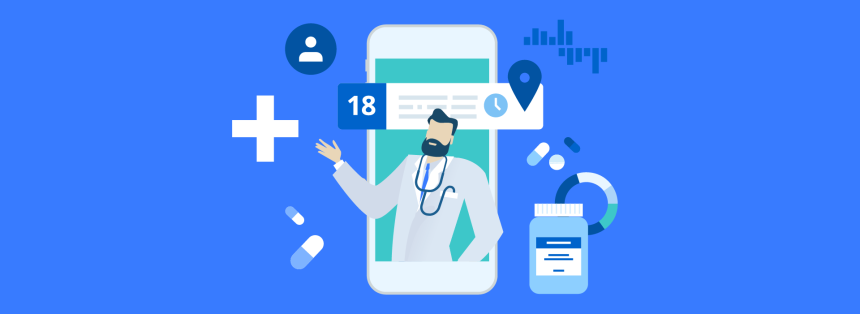What do the best healthcare app developers use to create outstanding solutions for the medical sector? To play the game of mHealth, you must keep an eye on the security, reliability, and efficiency of your app, all the while being available on the platforms your target audience uses. How do you do that? Let us take a look at the booming market of cross-platform development – this article gives you the five best frameworks to get you started.
Why opt for cross-platform?
Indeed, what makes cross-platform development so alluring? One of the pros is how it helps deal with swathes of information that often accompany mHealth. There are personal data, payment information, electronic medical and health records, doctor databases, etc. How does cross-platform development help here? Such frameworks are in high esteem for their security, optimization, and system update independence.
Security
Healthcare needs a robust back end. It deals with sensitive data, hence the need for stable and protected applications. Add dizzying legislation worldwide (HIPAA, GDPR, etc.) into the mix, and you get a pressing need for air-tight safety.
Cross-platform solutions incorporate many features that make the resulting product less likely to be broken into due to increased security. Pair it with cloud storage, and your medical records are safe and sound. What’s even better, everything is right where you need it, ready to be checked and sent across contact points.
Reliability
What about reliability? Top of the line here, no question. The frameworks are providing a stable experience regardless of what is happening with the OS. A new update will not ruin your app, and the software itself is getting a touch-up now and then, too. All of that matters a lot in healthcare app development since it directly impacts responsiveness and inclusivity that your audience cares about.
Efficiency
Cross-platform development ensures you can share code across different deployment points. That way, you are essentially making more apps at once. What’s even better, they are all easily tested and updated from one source. With that, your solution is going to reach more customers and fulfill their needs on their platform. Win-win. After all, it is of utmost importance to listen to your audience when developing a mHealth app. It is about starting with analyzing their pain points and implementing crucial bits of their feedback into your iterations. Honestly, with all the other things you need to consider when making a healthcare app, cross-platform development takes a huge load off your design and testing concerns.
Now that we’ve seen the benefits, let us examine the most popular cross-platform frameworks for building a healthcare application and what languages they run on.
Best Cross-Platform Frameworks
Flutter (Dart)
This framework by Google is one of the freshest options on the market and runs on Dart. It boasts an incredible graphics library and has great performance. Flutter is outstandingly maintained by a tech giant. As a result, it is a thriving open-source framework with a growing user base.
What are its best features that apply to healthcare? First of all, it was born out of an internal project that focused on a smooth frame rate. Therefore, the visual component of Flutter is extremely strong. We’re talking booming UI elements, impeccable motion, and efficient C++ usage to talk directly to the device. All this ensures the high productivity of your app. Following up, your users’ perception of your app’s performance is greatly improved by this frictionless interface.
An important aspect of a medical-oriented solution is to leave as little room for misunderstanding as possible. Your audience will most likely appreciate effective simplicity in the presentation. Therefore, you must be certain that your app is going to look just like you want it to on any device. Rejoice, because Flutter is capable of doing just that for you. A unified and highly customizable base of beautiful UI widgets will create a uniform look for your application. Android or iOS? No problem for Flutter. You could even go as far as to tinker with the elements to look like they are platform-specific for an added layer of native comfort. And with a capable graphics engine, your app is sure to handle your visuals just fine.
React Native (ReactJS)
Another one of the two most popular cross-platform frameworks, React Native is made by Facebook and runs on React. It is custom-made to deliver high-quality mobile applications.
What is the story behind it? Mark Zuckerberg was once upset with the way his app performed on Android and iOS. That is why an internal project was born out of the need for a lightning-fast and a fresh way forward. It all culminated in the 2015 launch of the framework. Thus, React Native is older than Flutter, hence an initially bigger community ready to help any novice to get on their feet. What’s great about it is that React is a JavaScript library, so many more people are familiar with it than any other framework-specific language.
One of the biggest pros of React Native is its complete accordance with the system look. Your app does not need any visual upgrades when a new OS update hits. Everything looks exactly like the native elements. Architecture-wise, React Native also firmly stands its ground. There are a ton of possibilities to optimize your app size and interface performance.
Xamarin (C#)
Xamarin is often revered as a champion of efficient code that boosts productivity and performance like no other framework. Supported by Microsoft, it amassed a sizable number of supporters all across the globe. Xamarin presents a strong structure and multi-use back end within a reliable system. It includes a multitude of tooling options and libraries. As a cross-platform framework, it also offers increased security. But you’re probably curious, what makes Xamarin truly unique?
If your back end runs on .NET, then you are in luck. .NET is what Xamarin is based on. Most of the logic, therefore, can be adapted to a multitude of platforms. Because the language this framework uses is C#, it is closely related to the vast space of platforms that run on C and its derivatives.
Xamarin gives developers a way into native APIs, so you can seamlessly integrate payment options like Google Wallet or Apple Pay. Moreover, you can add native UI or use a cross-platform tool to have a shared look across the board. All of the specific code for each platform is translated into a single layer of .NET, so the experience is smooth as a result. Testing your app using Xamarin is good too because you have access to thousands of device-specific scenarios to catch any mistakes.
It is no surprise that many companies use Xamarin to bring their storyboarded concepts to life with a rich feature set and commercial grade robustness.
Ionic (HTML, CSS, JS)
This framework is another brilliant open-source solution for your application. It can flaunt its impressive command-line interface, through which innovative and economically feasible apps are brought to market. Rapid deployment with a single base of code is enjoyed by millions of Ionic developers.
With ready-made scenes and an ability to use popular tech stacks or simple JavaScript, Ionic is easy to start with and use. You could enhance your experience by using Angular, or even Vue and React. To top it off, all of the elements are run by web technology like HTML and CSS, as well as JS. Therefore, it is familiar for developers and pleasant to interact with. There is no need to learn any additional languages, so it is effortless to find the right team for your project.
Apache Cordova (HTML, CSS, JS)
Cordova is also a great open-source wrapper for your apps that gives you access to native functions. Same as Ionic, you can write everything in HTML, JS, and CSS. It is especially good if your healthcare app is integrated with a desktop version. For example, a dashboard for medical staff or an extended personal cabinet for electronic records. These web language-oriented frameworks are amazing for developing an app for professionals. Prototyping won’t take long thanks to a set of wonderful UI templates and elements and a great back end.
Conclusion
If you are looking to develop a healthcare application that runs both on Android and iOS, or perhaps even desktop, web, Apple TV, and others, look no further than a robust cross-platform framework. To pick the right one, firstly consider what language it runs on, and what it can handle. Then, ask yourself what your priorities are and proceed accordingly. As you can see, there is a bunch of great options out there: Flutter, React Native, Xamarin, Ionic, and Apache Cordova. Each one has strong sides that will play well in healthcare development. It all depends on what you want. Be it an app for patients with a rich UI, or a powerful data-driven solution for doctors – cross-platform frameworks offer a cost-effective way to bring your idea to market.














